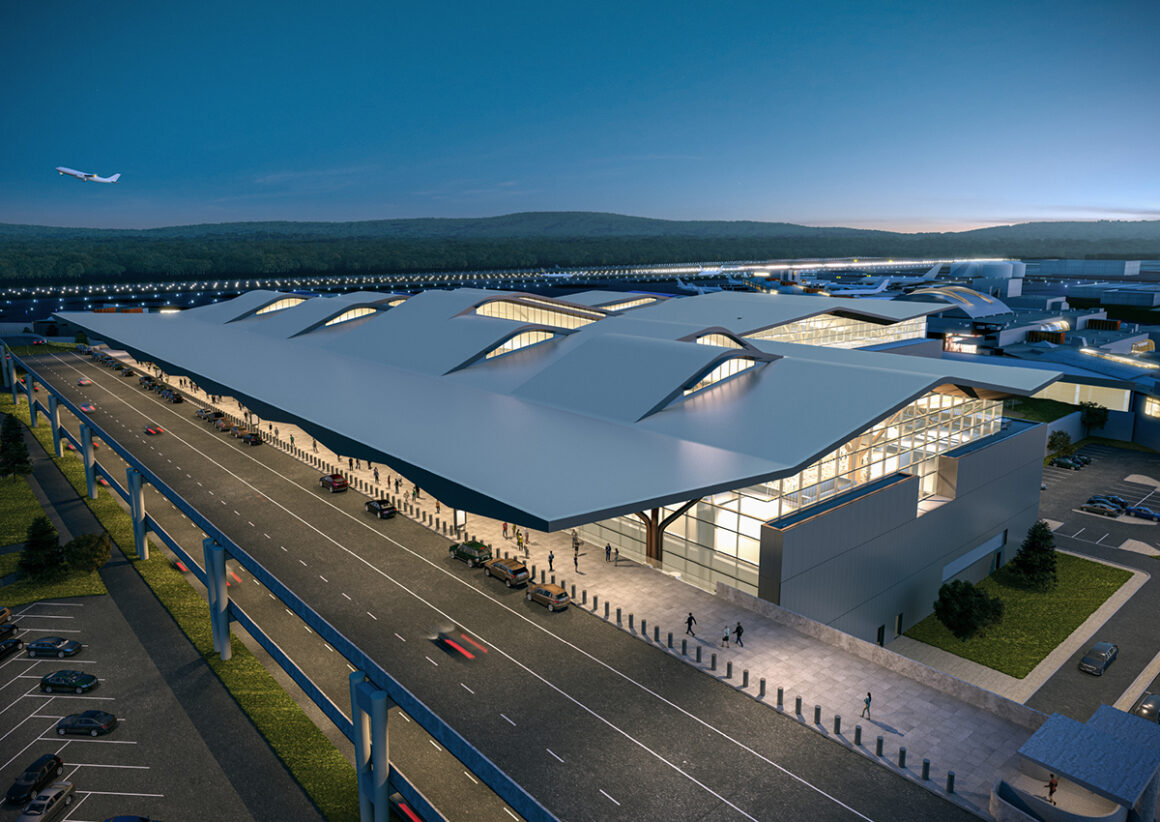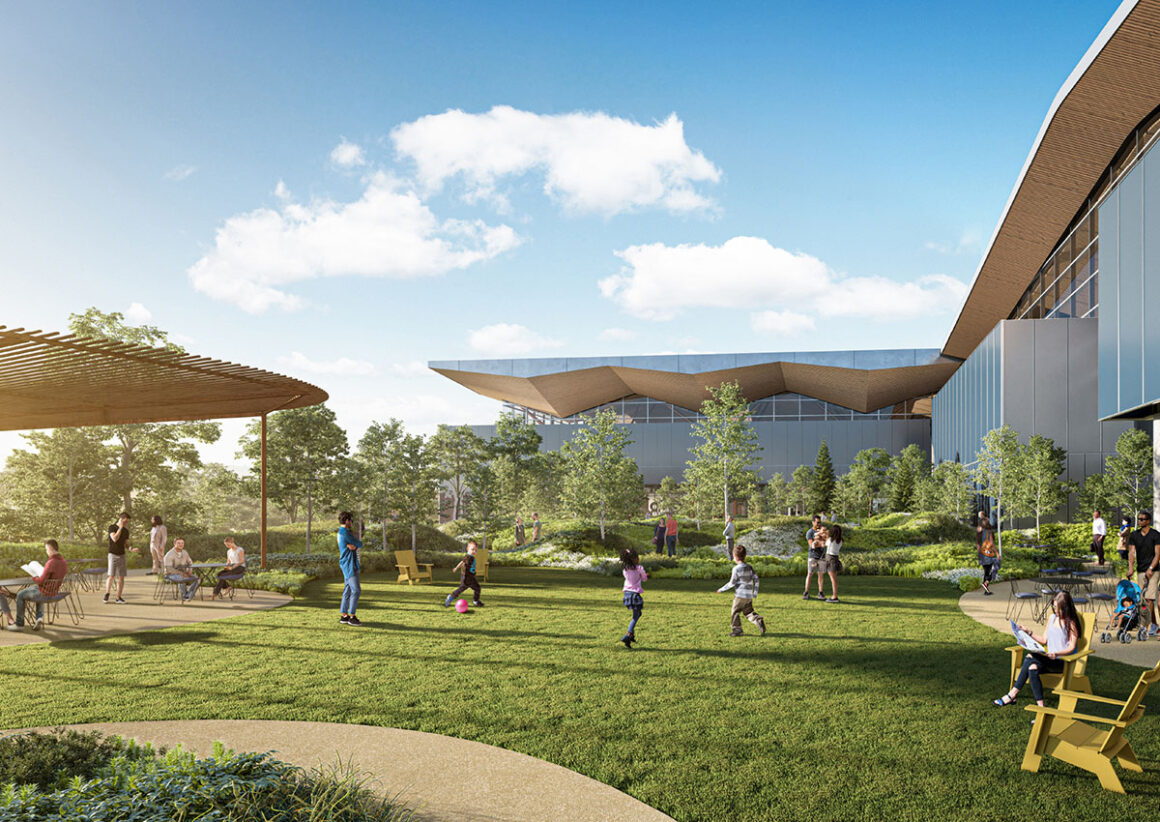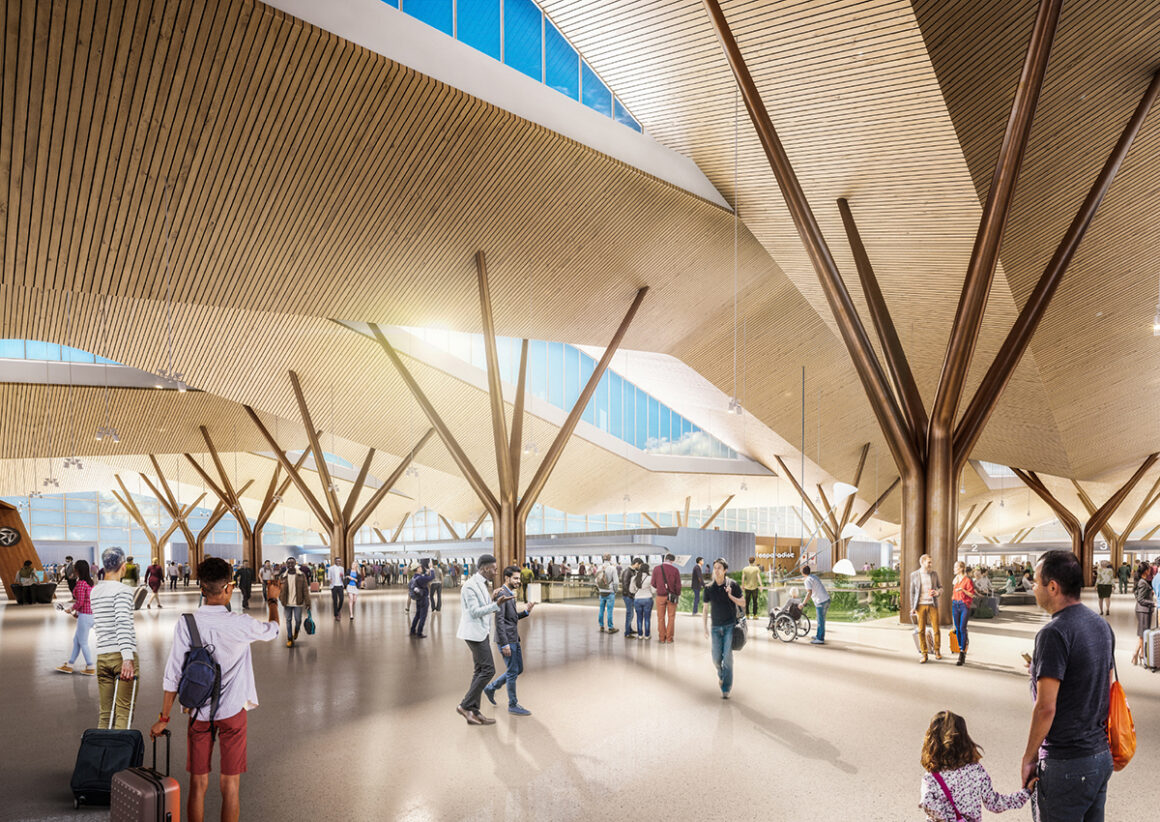Nearly one year ago, Pittsburgh International Airport (PIT) launched its massive $1.4 billion terminal modernization project.
Government and airport officials broke ground for the new 700,000 square-foot facility on 14 October 2021. When it opens in early 2025, it promises to transform the passenger experience for those traveling from, to, or through PIT.
The Current Airport is Showing its Age

The new facility will replace the current two-terminal system. At nearly thirty years old, the existing airport has outlived its useful life.
The current layout consists of the “landside terminal,” which houses airline ticket counters, shops, restaurants, car rentals, and TSA checkpoints. Once through TSA, the “airside terminal,” or the A, B, C, and D concourses, is accessible via a half-mile-long underground people mover train. The airside terminal features the “AirMall.” Now run by Fraport USA, it was once the largest airport shopping center in the United States. A commuter terminal, also known as the “E Gates,” was accessible by escalators from the landside terminal. However, the 22-gate “E” concourse was closed in 2003 after US Airways began to scale back – and eventually eliminate – its PIT hub.
The US Airways Effect

The existing airport replaced the former Greater Pittsburgh International Airport, which opened in 1952. USAir ran a burgeoning hub operation that had outgrown the space, even after several expansions through the years. When the new airport opened in 1992, it opened with 75 gates with the ability to expand to 100. Unfortunately, the terrorist attacks of 11 September 2001 led to serious financial difficulties at what was now US Airways.
US Airways began to scale back operations amid the downturn in air travel following the 9/11 attacks. Ultimately, the carrier de-hubbed PIT. As a result, passenger traffic plummeted, and the expansive airport became a shell of its former self.
Since the early 2000s, PIT has reinvented itself by attracting new carriers and routes. However, passenger counts exceeding 20 million at the turn of the century during the height of US Airways’ PIT hub operation are but a distant memory. Passenger traffic continued to decrease following 9/11 until stabilizing in the late 2000s. After relative stability in the early to mid-2010s, and prior to the pandemic, passenger counts were slowly approaching 10 million. Impressive, but still less than half the number of passengers before 9/11. It was clear that Pittsburgh needed to right-size its airport.
Along with right-sizing PIT, the new terminal will transform it into a sustainable, efficient, and modern example of a 21st-century airport.
Streamlining the Passenger Experience

From the moment a passenger arrives by car, they will experience a streamlined process, including a new roadway system, a multi-level smart parking garage, and the consolidation of ticketing, security, and baggage claim in one area.
The new process will reduce the time it takes to get from curb to gate by 50 percent. Currently, passengers must navigate through a three-level maze to the airline ticket counters and two TSA checkpoints via a confusing and inefficient series of elevators and escalators.
Once inside security, a more efficient 51-gate layout will allow passengers to navigate to their gate effortlessly.
A Focus on Clean Air and Nature

Pittsburgh’s new terminal will have the distinction of becoming America’s first terminal built from the ground up in the post-pandemic world. The design will feature multiple elements that enhance public health.
The elevated, three-tier structure will utilize clean air technology, enhanced ventilation systems, and large open areas enabling travelers to spread out. The terminal will feature a natural wood ceiling and floor-to-ceiling windows designed to let in as much natural light as possible.
Perhaps most impressive, however, is the 90,000 square foot outdoor terrace space. Accessible to travelers both pre- and post-security, this outdoor space will allow travelers to get some fresh air, enjoy nature, and maybe even have a picnic on the lawn while waiting for a flight.
A Commitment to Sustainability

The new airport will be the first to generate its own power by a microgrid. Powered by five natural gas generators that source their fuel onsite, the 23-megawatt grid went online in July 2021. More than 9,000 solar panels installed on a former landfill also contribute to power generation.
At least 75 percent of waste generated by the construction of the new terminal will be recycled or reused. The new roadway system to the terminal will feature recycled concrete from existing airfield infrastructure. The airport will also harvest rainwater.
All construction will be LEED-certified, meaning that the facility will be among the most sustainable buildings in the world.
A True World-Class Airport

When the Terminal Modernization Program is complete in 2025, PIT will cement its spot as a world-class airport.
Although nowhere near the number of flights it saw during US Airways’ heyday, PIT currently offers 125 daily flights to more than 70 destinations. PIT is served by 15 airlines, including British Airways 787 service to London-Heathrow (LHR).
As demand for air travel increases post-pandemic, the updated Pittsburgh International Airport will be well-positioned to take advantage of the growth and will serve the needs of southwestern Pennsylvania for decades to come.
